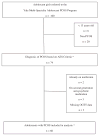Polycystic ovary syndrome in adolescence: impaired glucose tolerance occurs across the spectrum of BMI
- PMID: 22925367
- PMCID: PMC4864958
- DOI: 10.1111/j.1399-5448.2012.00902.x
Polycystic ovary syndrome in adolescence: impaired glucose tolerance occurs across the spectrum of BMI
Abstract
Context: Polycystic ovary syndrome (PCOS) is a chronic condition with metabolic manifestations spanning the reproductive years.
Objective: We sought to examine glucose metabolism, irrespective of the presence of obesity in a cohort of adolescent girls with PCOS.
Design: One hundred adolescents were assessed for PCOS in a multi-specialty adolescent PCOS program. PCOS was diagnosed by Androgen Excess Society criteria. Oral glucose tolerance testing (OGTT), homeostatic model assessment of insulin resistance, and androgen and lipid profiles were performed for those meeting criteria.
Results: Sixty-six adolescents (mean age 15.8 ± 0.2 yrs, range 13.0-18.6) had confirmed PCOS, and were eligible for inclusion in our analysis. Abnormal glucose metabolism was present in 12 of 66 (18.2%) subjects: 2 (3.0%) impaired fasting glucose, 10 (15.2%) impaired glucose tolerance (IGT), and 1 (1.5%) type 2 diabetes. IGT was the most common abnormality, occurring with equal frequency in obese (OB, mean body mass index (BMI) 36.9 ± 0.8 kg/m(2) ) and non-obese (NOB, mean BMI 24.5 ± 0.6 kg/m(2) ) adolescents (p = 0.3). In a subgroup analysis, NOB adolescents with IGT (NOB-IGT) had similar mean 2-h insulin, high density lipoprotein, C-reactive protein, and testosterone levels to the OB cohort despite marked differences in BMI (p < 0.001) and % body fat (p = 0.002). However, the NOB-IGT group had a lower mean fasting insulin level than the OB cohort (p = 0.04).
Conclusion: Abnormal glucose metabolism is highly prevalent in adolescents with PCOS. In particular, IGT occurs across the spectrum of BMI. A screening OGTT should be considered for adolescents diagnosed with PCOS, independently of their BMI.
© 2012 John Wiley & Sons A/S.
Figures



Similar articles
-
Dysglycemia screening with oral glucose tolerance test in adolescents with polycystic ovary syndrome and relationship with obesity.BMC Endocr Disord. 2022 Jul 16;22(1):180. doi: 10.1186/s12902-022-01098-0. BMC Endocr Disord. 2022. PMID: 35842601 Free PMC article.
-
Assessment of insulin resistance and impaired glucose tolerance in lean women with polycystic ovary syndrome.J Womens Health (Larchmt). 2011 Jan;20(1):37-43. doi: 10.1089/jwh.2010.2053. Epub 2010 Dec 31. J Womens Health (Larchmt). 2011. PMID: 21194310 Free PMC article. Clinical Trial.
-
The prevalence and risk factors for glucose intolerance in young Korean women with polycystic ovary syndrome.Endocrine. 2009 Oct;36(2):326-32. doi: 10.1007/s12020-009-9226-7. Epub 2009 Aug 14. Endocrine. 2009. PMID: 19688613
-
Metabolic effect of obesity on polycystic ovary syndrome in adolescents: a meta-analysis.J Obstet Gynaecol. 2017 Nov;37(8):1036-1047. doi: 10.1080/01443615.2017.1318840. Epub 2017 Jun 28. J Obstet Gynaecol. 2017. PMID: 28657375 Review.
-
AMERICAN ASSOCIATION OF CLINICAL ENDOCRINOLOGISTS, AMERICAN COLLEGE OF ENDOCRINOLOGY, AND ANDROGEN EXCESS AND PCOS SOCIETY DISEASE STATE CLINICAL REVIEW: GUIDE TO THE BEST PRACTICES IN THE EVALUATION AND TREATMENT OF POLYCYSTIC OVARY SYNDROME - PART 2.Endocr Pract. 2015 Dec;21(12):1415-26. doi: 10.4158/EP15748.DSCPT2. Endocr Pract. 2015. PMID: 26642102 Review.
Cited by
-
Probiotics and Polycystic Ovary Syndrome: A Perspective for Management in Adolescents with Obesity.Nutrients. 2023 Jul 14;15(14):3144. doi: 10.3390/nu15143144. Nutrients. 2023. PMID: 37513562 Free PMC article. Review.
-
PCOS in Adolescents-Ongoing Riddles in Diagnosis and Treatment.J Clin Med. 2023 Feb 3;12(3):1221. doi: 10.3390/jcm12031221. J Clin Med. 2023. PMID: 36769869 Free PMC article. Review.
-
Dysglycemia screening with oral glucose tolerance test in adolescents with polycystic ovary syndrome and relationship with obesity.BMC Endocr Disord. 2022 Jul 16;22(1):180. doi: 10.1186/s12902-022-01098-0. BMC Endocr Disord. 2022. PMID: 35842601 Free PMC article.
-
Effects of Kelulut Honey on Oestrus Cycle Regulation and Histomorphological Changes in Letrozole-Induced Polycystic Ovary Syndrome Rats: A Preliminary Study.Life (Basel). 2022 Jun 14;12(6):890. doi: 10.3390/life12060890. Life (Basel). 2022. PMID: 35743921 Free PMC article.
-
Clinical, Metabolic and Hormonal Profiles of Bangladeshi Adolescents with Polycystic Ovary Syndrome.touchREV Endocrinol. 2021 Apr;17(1):54-58. doi: 10.17925/EE.2021.17.1.54. Epub 2021 Apr 28. touchREV Endocrinol. 2021. PMID: 35118446 Free PMC article. Review.
References
-
- Asuncion M, Calvo RM, San Millan JL, Sancho J, Avila S, Escobar-Morreale HF. A prospective study of the prevalence of the polycystic ovary syndrome in unselected Caucasian women from Spain. J Clin Endocrinol Metab. 2000;85:2434–2438. - PubMed
-
- Azziz R, Woods KS, Reyna R, Key TJ, Knochenhauer ES, Yildiz BO. The prevalence and features of the polycystic ovary syndrome in an unselected population. J Clin Endocrinol Metab. 2004;89:2745–2749. - PubMed
-
- Solomon CG, Hu FB, Dunaif A, et al. Long or highly irregular menstrual cycles as a marker for risk of type 2 diabetes mellitus. JAMA. 2001;286:2421–2426. - PubMed
-
- Legro RS, Kunselman AR, Dodson WC, Dunaif A. Prevalence and predictors of risk for type 2 diabetes mellitus and impaired glucose tolerance in polycystic ovary syndrome: a prospective, controlled study in 254 affected women. J Clin Endocrinol Metab. 1999;84:165–169. - PubMed
-
- Ehrmann DA, Barnes RB, Rosenfield RL, Cavaghan MK, Imperial J. Prevalence of impaired glucose tolerance and diabetes in women with polycystic ovary syndrome. Diabetes Care. 1999;22:141–146. - PubMed
Publication types
MeSH terms
Substances
Grants and funding
LinkOut - more resources
Full Text Sources
Medical
Research Materials
Miscellaneous


